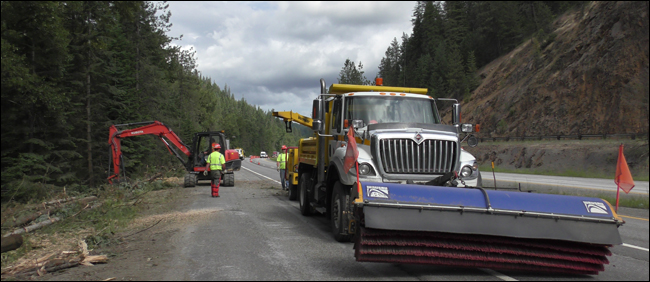

District 1 revisits hazard-tree removals
to save big money
![]()
To enhance highway safety, crews in District 1 (north Idaho) regularly remove hazardous trees growing near the roadsides throughout the region. Trees can fall onto the road or act as obstacles in the shoulder if vehicles leave the roadway. The trees can also shade roadways and cause icy conditions in winter, or hide approaching wildlife.
A two-mile section along Interstate  90 at Fourth of July Pass is finally being addressed, thanks to a partnership with the Idaho Department of Lands. The district was able to bring a contractor on board at no cost to the taxpayers. These trees hadn't been addressed previously because it wasn't safe for our crews or feasible with our equipment or cost effective.
90 at Fourth of July Pass is finally being addressed, thanks to a partnership with the Idaho Department of Lands. The district was able to bring a contractor on board at no cost to the taxpayers. These trees hadn't been addressed previously because it wasn't safe for our crews or feasible with our equipment or cost effective.
Now, in addition to the removal of dead and dying haz ard trees near the roadside on 200 acres of state property, the contractor will harvest other trees in the area to cover operating costs. ITD developed this logging project with assistance from the Idaho Department of Lands.
ard trees near the roadside on 200 acres of state property, the contractor will harvest other trees in the area to cover operating costs. ITD developed this logging project with assistance from the Idaho Department of Lands.
“Given the number of trees that need to be removed in this section, the old way wasn’t feasible,” District 1 Operations Engineer Jerry Wilson said. “If this process works well, ITD could continue to use similar partnerships to increase safety along the entire corridor.”
Hazard tree removal is an annual occurrence in north Idaho to safeguard the driving public.
ITD will pay no extra money for this safety improvement and will instead be able to direct funds to other maintenance activities.
Without this contract, this work would likely never have been done. Not only would it require significant manhours (an estimated 100 hours are spent per year on just this six-mile section dealing with fallen hazard trees), but it would also require specialized training and equipment ITD does not have, meaning it would have to be hired out.
An estimated 1,500 hazard trees were removed with this project (not including marketable timber), and if those were hired out at $500 apiece for equipment, personnel and tree disposal, it would have cost ITD at least $750,000, and ultimately, never been done due to budget constraints.
Pictured below are tree-removal operations from last summer.


Published 05-03-19